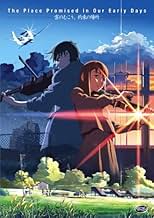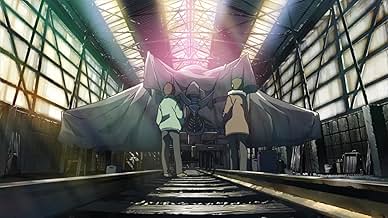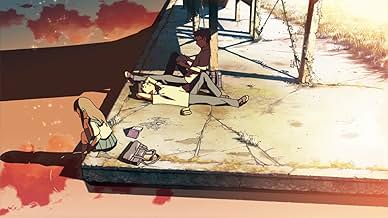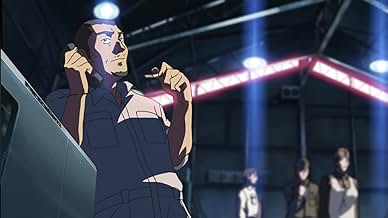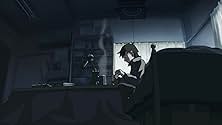NOTE IMDb
6,8/10
16 k
MA NOTE
Ajouter une intrigue dans votre langueIn an alternate postwar timeline, Japan is divided into the Union-controlled North and the US-controlled South.In an alternate postwar timeline, Japan is divided into the Union-controlled North and the US-controlled South.In an alternate postwar timeline, Japan is divided into the Union-controlled North and the US-controlled South.
- Réalisation
- Scénario
- Casting principal
- Récompenses
- 1 victoire et 1 nomination au total
Yuka Nanri
- Sayuri Sawatari
- (voix)
- (as Yuuka Nanri)
Unshô Ishizuka
- Okabe
- (voix)
Kazuhiko Inoue
- Tomizawa
- (voix)
Risa Mizuno
- Maki Kasahara
- (voix)
Hidenobu Kiuchi
- Arisaka
- (voix)
Takeshi Maeda
- Daigakuinsei
- (voix)
- …
Rie Nakagawa
- Joshi Seito
- (voix)
- …
Yûki Nakao
- Joshi Seito
- (voix)
Maki Saito
- Joshi Seito
- (voix)
- (as Maki Saitou)
- …
Bretto Coleman
- Beigunjin
- (voix)
Ian O'Neal
- NSA
- (voix)
Avis à la une
Mind-bending sci-fi is a staple of Japanese animation, and many of them are complex in a way that makes them difficult to grasp immediately. This one, though, I really don't think the director has any idea how to tell a story. The film is just never coherent. Not only is its science fiction premise (which deals with alternate universes) never clear, nor its world comprehensibly established, but it's terrible at establishing characters and their relationships to each other. All of the characters are quite thin and clichéd. The artwork is nice(the animation is a bit choppy, though), and the music is pretty (but also occasionally too sappy), but this is an annoying mess of a film.
Makoto Shinkai is unique in his directing style in that he often places more focus on a character's inner thoughts rather than his or her dialogue and interacting with the environment. While this style has its own set of strengths and weaknesses, Shinkai uses it to his advantage to often show a emotion driven story. Such as is here in "The Place Promised in our Early Days." It is not a good as some of his other efforts, but it is still worth the watch nonetheless. The story is about three friends living in a alternate reality Japan. Japan has been split in have by America who controls the south and "the Union" controlling the north. There is a tower that goes beyond the clouds and the three friends make a promise to go fly up to it using a plane that they salvage and start to repair. One day, one of the friends disappear and story follows the other two friends and how they cope and ultimately try to find and help her. Like I said, the setting is in a alternate history and there are some science fiction influences in the world. However, it does not detract from the highlight which is he story. The first part of the story involves the three friends enjoying their summer. It is so genuine in terms of emotion and the bright lighting and beautiful drawn environments really brings the story to life. The character animations is not the best and the voice acting is OK at best, but the environments themselves are so beautiful that you'll easily forgive the previous complaints. Shinkai excels at portraying emotions of lost and isolation, especially when it involves old friends and lost lovers. It is no exception here. The main character is the most developed here as we hear his inner thoughts the most and his desire to see his lost friend again is interesting. As much as I like this movie, it is hard not to compare it to another Makoto Shinkai film, "5cm per Second." The reason I like that film better is because there was nothing that distracted the main story. It was clear and to the point with nothing distracting. Same can't be said for this movie. There is a lot of background here involving politics and a weird dream/ parallel universe science that gets convoluted and messy and at times, it can get distracting. That being said, if you want a movie with genuine emotion, this is not a bad watch. In a age where anime tends to focus less on story and more and cutesy hi jinks and everyday nonsense of high school students who can't get a girl, "The Place Promised in our Early Years" is a refreshing, emotional, and occasionally beautiful film that won't leave and tears in your eyes, but might leave you staring at the screen even after the credits start rolling.
Read the title a couple of times.
It's lyrical, evocative, even elegiac, and yet could have been expressed in fewer words.
Such is this film.
Formally, it's a pure joy to behold. From sweeping countryside panoramas and old, weatherbeaten structures that somehow plumb deep-seated sparks of nostalgia, to sweetly-embellished details like a softly rattling electric fan, Shinkai creates a vibrant, human environment. The soundtrack is equally enveloping, with heart-melting violin and piano work.
Beyond this is quite a decent film, with believable characters in often hard-to-fathom situations. The boyhood friendship of the two male protagonists is very real -- but their ability to engineer, fabricate, and pilot a sophisticated aircraft at age 15 is purely the stuff of anime fantasy.
And yet, everything, no matter how incredible or convoluted, is wrapped in these Shinkai layers of lyricism and beauty. Through a very sensitive and even transcendent treatment, scene after scene is made to appear pivotal, even if it's not.
And thus we have a film that is almost cloying in its presentation -- it's not layered with pure sugar; most of the time it feels genuine, even if it's becoming self-indulgent. But indulge it does, because the director knows how to indulge gracefully.
Normally style over substance kills substance. In "Place," it gently infuses it with some sort of warm, nourishing milk.
It's lyrical, evocative, even elegiac, and yet could have been expressed in fewer words.
Such is this film.
Formally, it's a pure joy to behold. From sweeping countryside panoramas and old, weatherbeaten structures that somehow plumb deep-seated sparks of nostalgia, to sweetly-embellished details like a softly rattling electric fan, Shinkai creates a vibrant, human environment. The soundtrack is equally enveloping, with heart-melting violin and piano work.
Beyond this is quite a decent film, with believable characters in often hard-to-fathom situations. The boyhood friendship of the two male protagonists is very real -- but their ability to engineer, fabricate, and pilot a sophisticated aircraft at age 15 is purely the stuff of anime fantasy.
And yet, everything, no matter how incredible or convoluted, is wrapped in these Shinkai layers of lyricism and beauty. Through a very sensitive and even transcendent treatment, scene after scene is made to appear pivotal, even if it's not.
And thus we have a film that is almost cloying in its presentation -- it's not layered with pure sugar; most of the time it feels genuine, even if it's becoming self-indulgent. But indulge it does, because the director knows how to indulge gracefully.
Normally style over substance kills substance. In "Place," it gently infuses it with some sort of warm, nourishing milk.
I gave 4 stars just for the art and the music, but I really got bored a lot watching this, the story makes no sense, it's all so dreamy, so epic, the author wants you to deeply feel all this emotions but to me the result it's an hollow movie with hollow character. I've never fallen asleep watching something, but with this I barely succeeded to end it. I definitively suggest not to watch it, there are so many other beautiful anime to see out there. One thing I've enjoyed is the artwork, the landscapes are really intense and make you dream, but also there sometimes there is too much over production, too many light effects, it seems like a punch in the eye. And I hate when authors use science fiction in this way, by throwing here and there some gibberish theory and then making a mess with a convoluted plot, so that people at the end can say that it leave you with the freedom to interpret it, I find this technique over abused lately, and by the way I've never seen using it so badly like in this case
10StarAxis
This is an anime movie done by a relative newcomer to films: Makoto Shinkai, whose only previous directorial work was a half-hour short called "Voices of a Distant Star," in which he did all the animation himself on one laptop (even for Japan, a nation of workaholics, that was unheard of). It made him so famous that they gave him a full studio to work with for his next project, and when Makoto Shinkai doesn't have the constraints that a solo project would bring, look out.
The style of the film and its sci-fi and fantasy themes is equal parts steampunk and cyberpunk, with the film taking place in an alternate timeline of post-war Japan, only a few years from now. The main differences are the division between the North and South sides of Japan, and the research into parallel universes that has sprung up, resulting in the construction of a massive tower in Ezo (Hokkaido), which understandably captures the imagination and curiosity of the surrounding world.
Though the film is ostensibly a science fiction work, the plot involving a tower and alternate realities and so on plays second fiddle to the romantic drama, about three high school kids torn apart by war. The emotions blend with the fantasy elemts in a way that is handled with incredible elegance, care and sensitivity, and Makoto Shinkai's trademark poetic touch.
But what is more impressive is how the film shows that drama can be achieved through implausible situations. You see, too many directors think that in order to make a film "dramatic" and "touching," it must be about REALISTIC people in a REALISTIC setting having REALISTIC problems with REALISTIC resolutions, but Makoto Shinkai realizes a way around that, and uses a science fiction element not as a platform for action sequences, but rather as a way to achieve a kind of drama that you really couldn't get in a film that takes place in the "real world."
The film is aware that the sci-fi is playing second fiddle to the character drama, and doesn't waste any more time than it needs to trying to explain the film's bizarre sciences or justify the contrivances, rather leaving it up to the viewer to interpret and decipher what the fantasies of the film mean or symbolize. In other words, Shinkai wisely avoids the deathtrap of "Movie Science," and instead allows the audience to take things as they come and explain them ourselves.
The part about two teenagers building a plane that could get past a government-built radar system does seem a bit incredible, but this film does reflect on the incompetence of governments and how easy it is to get past them, so the required suspension of disbelief isn't really that big (I wish I found it hard to believe that a couple of teenagers could get past a bureaucratic governmental system in this day and age at all).
Also, the brief violence and "thrilling" assault on the tower are treated with perfect sincerity. The brief fight scenes are breathtaking in their realism and how they show that when someone gets punched, they get hurt. There are no legendary martial arts techniques or complex laser-rifle technology here, this film is about how people feel about each other and what they do when they are in trouble.
The ending is slightly abrupt and somewhat open-ended (although it is happy), but that is a theme in many anime. A lot is left up to the audience's interpretation and imagination, and the film only answers the questions that really matter.
The style of the film and its sci-fi and fantasy themes is equal parts steampunk and cyberpunk, with the film taking place in an alternate timeline of post-war Japan, only a few years from now. The main differences are the division between the North and South sides of Japan, and the research into parallel universes that has sprung up, resulting in the construction of a massive tower in Ezo (Hokkaido), which understandably captures the imagination and curiosity of the surrounding world.
Though the film is ostensibly a science fiction work, the plot involving a tower and alternate realities and so on plays second fiddle to the romantic drama, about three high school kids torn apart by war. The emotions blend with the fantasy elemts in a way that is handled with incredible elegance, care and sensitivity, and Makoto Shinkai's trademark poetic touch.
But what is more impressive is how the film shows that drama can be achieved through implausible situations. You see, too many directors think that in order to make a film "dramatic" and "touching," it must be about REALISTIC people in a REALISTIC setting having REALISTIC problems with REALISTIC resolutions, but Makoto Shinkai realizes a way around that, and uses a science fiction element not as a platform for action sequences, but rather as a way to achieve a kind of drama that you really couldn't get in a film that takes place in the "real world."
The film is aware that the sci-fi is playing second fiddle to the character drama, and doesn't waste any more time than it needs to trying to explain the film's bizarre sciences or justify the contrivances, rather leaving it up to the viewer to interpret and decipher what the fantasies of the film mean or symbolize. In other words, Shinkai wisely avoids the deathtrap of "Movie Science," and instead allows the audience to take things as they come and explain them ourselves.
The part about two teenagers building a plane that could get past a government-built radar system does seem a bit incredible, but this film does reflect on the incompetence of governments and how easy it is to get past them, so the required suspension of disbelief isn't really that big (I wish I found it hard to believe that a couple of teenagers could get past a bureaucratic governmental system in this day and age at all).
Also, the brief violence and "thrilling" assault on the tower are treated with perfect sincerity. The brief fight scenes are breathtaking in their realism and how they show that when someone gets punched, they get hurt. There are no legendary martial arts techniques or complex laser-rifle technology here, this film is about how people feel about each other and what they do when they are in trouble.
The ending is slightly abrupt and somewhat open-ended (although it is happy), but that is a theme in many anime. A lot is left up to the audience's interpretation and imagination, and the film only answers the questions that really matter.
Le saviez-vous
- AnecdotesMakoto Shinkai intended to draw the background art himself but with an estimated 1000 cuts needed this would have been impossible for Shinkai to do alone and the film's animation producer, Kiyonori Hiramatsu went to Tokyo Art University to scout for artists. Adding to complications, many of the students were recruited from oil painting classes and had no experience in creating digital backgrounds and many hadn't even used PCs before.
- GaffesEnglish subtitles spell prophecies (used as a noun) as prophesies (the verb).
- Citations
Hiroki Fujisawa: [Narrating] Living alone, the nights seemed to last forever. When I couldn't pass the time effectively, I went to a nearby train station and pretended to wait for someone.
- Crédits fousThere's a brief shot after the credits.
- ConnexionsFeatured in WatchMojo: Top 10 Underappreciated Anime Movies (2016)
Meilleurs choix
Connectez-vous pour évaluer et suivre la liste de favoris afin de recevoir des recommandations personnalisées
- How long is The Place Promised in Our Early Days?Alimenté par Alexa
Détails
- Date de sortie
- Pays d’origine
- Site officiel
- Langue
- Aussi connu sous le nom de
- The Place Promised in Our Early Days
- Société de production
- Voir plus de crédits d'entreprise sur IMDbPro
Box-office
- Montant brut mondial
- 90 406 $US
- Durée1 heure 30 minutes
- Couleur
- Mixage
- Rapport de forme
- 1.85 : 1
Contribuer à cette page
Suggérer une modification ou ajouter du contenu manquant


